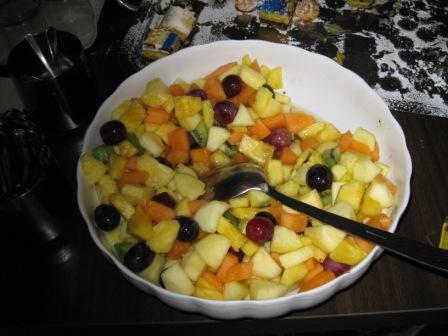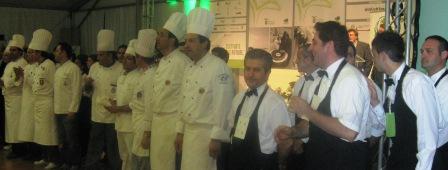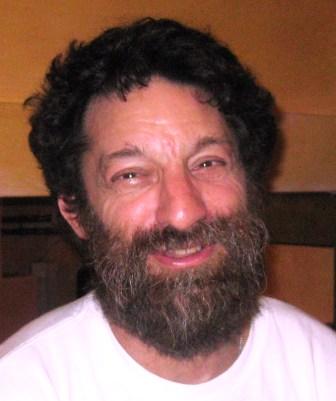
The fruit in Modena restaurants is delicious, whether chopped up into a fruit medley in a large bowl at the buffet of the Cafe Concerto on Modena's Piazza Grande...

...or teased by the chefs of the Francescana (Pavarotti's favorite restaurant) into pureed pears, Vignola cherries mixed with aceto balsamico, and a peach mousse, as in the Organic World Conference's all-organic gala dinner.
Researchers present 70 scientific papers, most listed below with titles and first author - enough information to locate the paper via Google or the Conference website. Articles in italics are available from the ATTRA National Sustainable Agriculture Service.
Consumer Reports, using work of the Environmental Working Group, singles out fruit that is starred (*) as worth a marketplace premium: apples, cherries, imported grapes, nectarines, peaches, pears, raspberries and strawberries -- or all fruit for baby food. The reason? Risks from pesticides. But the list is much too short because it does not take into account consumers' responsibility for the impact of pesticides on farm workers and farmland.
D. Pearson reports that Australian consumers buy most of their fruit at a fruit specialist (a "fruit barn"), then finish their weekly shopping at a supermarket. Fruit shopping tends to be on impulse, based on availability and price. Organic fruit is a small portion of the total and is purchased for its health and taste attributes and to a lesser extent its environmental impact. Australian consumers appear to be willing to pay a 20 percent premium for organic fruit.
Apples* - Scab-resistant varieties (G. Alins, S. Allegre and I. Iglesias), experimental apple tree treatments (Basak, Bielicki, Pawel), Quality of organic vs. conventional (G. Bertazza et al.), "Arbokost" managerial software for organic apple production (E. Bravin et al.), Insect and disease management (K. Delate), Options for starting an organic apple orchard (M. E. Garcia), Challenges in organic production in the eastern United States (G. Krawczyk et al.), Comparison of organic and integrated fruit production systems for the "liberty" apple in New York (G. Peck and I. Merwin). Organic and Low-Spray Apple Production. Considerations in Organic Apple Production.
Apricots - Quality of organic vs. conventional (G. Bertazza et al.), Fruit quality at harvest and after storage under different environmental conditions (A. Leccese).
Blackberries - Antioxidant characteristics and total polyphenol content (Gy. Gyorene Kis et al.), High tunnel production of organic blackberries in Arkansas (C. R. Rom et al.), Organic highbush production systems (W. Scarappa et al.), Organic Culture of Bramble Fruits.
Blueberries - Vegetation and nitrogen dynamics for organic management (N. E. Burkhard), Large-scale production in Chile (R. Montalba et al.), Long-term effects of pH regulation (F. Suter et al.), Blueberries: Organic Production.
Cherries* - Dehydrofreezing, cultivar selection (S. Gobbi et al.), Physicochemical characteristics and antioxidant activity of sweet cherries (M. Plessi et al.), Use of nets against fruit cherry fly (V. Ughini et al.), The slow food "presidium" of traditional Vignola cherries (S. Zocca).
Grapes* (see also Green Edge 2 on Organic Winemaking). Response of grapevine trees to increasing copper concentration (M. Toselli et al.), Grapes: Organic Production.
Kiwifruit - Control of pathogens (G. M. Balestra et al.),=2 0natural antagonist against phylobacteria (G. M. Balestra), Quality changes in kiwifruit after long-term cold storage (A. Leccese et al.).
Lychees - Organic production in Australia (A. Leu).
Melon - Muskmelon growth, yield and nitrogen accumulation in Eastern China (P. Lehne).
Nectarines* - No papers.
Olives - Nonchemical method for monitoring weevil populations (A. El Jiatil), New "attract and kill" devices against Bactrocea Oleae (N, Iannota), Olive root growth (C. Ponzio et al.).
Oranges - Yield and fruit quality opf "Valencia Late" oranges in response to organic fertilization (F. Intrigliolo et al.).
Pawpaw - indigenous to the eastern United States, so named because superficially similar to papaya, popular among U.S. organic growers because it is not attractive to pests, has medicinal uses. Pawpaw Production.
Papaya - Integrated fertilizers (S.O.S. Akinyemi, M. O. Akande).
Peaches* - Detection of inorganic chemicals (S. Arnone et al.), Peach aphids management (S. Penvern et al.), Organic and Low-Spray Peach Production.
Pears* - Quality of organic vs. conventional production (G. Bertazza et al.), Response of potted pear trees to increasing copper concentration (M. Toselli et al.), Organic Pear Production.
Persimmons - Persimmon Production.
Plums - Low-Spray & Organic Plum Production.
Raspberries* - Antioxidant characteristics and total polyphenol content (Gy. Gyorene Kis et al.), High tunnel production of organic blackberries in Arkansas (C. R. Rom et al.), Organic Culture of Bramble Fruits.
Strawberries* - Content of anthocyanins (I. Baiamonte et al.), varieties of organic strawberries (S. Foschi), Biological control agents in organic production (S. Shakya et al.), Bioactive molecule content (A. Tarozzi et al.), Strawberries: Organic & Integrated Pest Management Options.

Marty Mesh, Founder, Florida Organic Growers (FOG, www.foginfo.org). The Organic World Congress is so huge in topic coverage and meeting area that I am naturally drawn toward interviewing individual participants in the program. What kind of person travels here to submit to a grueling barrage of technical reports?
Marty Mesh has come here from Gainesville, Florida -- a state famous for its oranges and other fruit. Marty created an NGO to promote and certify organic food, the Florida Certified Organic Growers and Consumers, abbreviated FOG. It obtains grant money from food programs, runs educational conferences and gets involved with public policy issues. It has an EPA grant to help a conventional grower replace some of its use of pesticides. Most of its revenue comes from certification, under the name Quality Certification Services, which concentrates its work in seven Florida regions and focuses on organic and food safety issues. It also does some work globally.
What was his motivation in creating FOG? He felt it was the right thing for him to do and was challenged by being told that there was no market for organic food in Florida. The marketplace has validated his initiative and he is pleased to see now that the University of Florida has created a Center for Organic Agriculture and is offering a degree in the field. He is also pleased that the latest farm bill coming out of Washington has substantial new organic incentives. He has spent some time in Washington working on policy issues and has been involved in training of organic farmers in Taiwan (some of whom are at the conference lobbying to be the next site of the triennial Organic World Congress, in 2011).
Marty believes that higher petroleum prices have forced everyone to look again at organic agriculture because the old model based on heavy use of fertilizers and pesticides is suddenly facing a doubling or tripling of some costs of production. A starting point for change is with the seeds themselves. Many seeds have been bred for use with fertilizers and pesticides and for a long shelf life. Howard Shapiro (a speaker at the opening plenary panel of the Organic World Congress) has been looking for seeds that will produce a hardier plant.
Marty thinks that many new entrants into the organic field are there because they see money either in the farming or in the verification programs. It wasn't his motivation, but he is encouraged by seeing newcomers to the field.